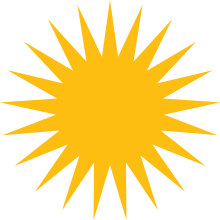The Kurdish Sun, also commonly referred to by its Kurdish name: Kurdish: ڕۆژ, romanized: Roj, is a burning golden sun and the national emblem of the Kurds. It's also found inside the flag of Kurdistan and the official flag of the Kurdistan Region. The sun disk of the emblem contains 21 rays of equal size and shape. The number 21 also symbolizes March 21, the holiday of Newroz, which is the Kurdish New Year.[1][2][3][4]

History
editFlags used
edit-
The first version of the modern Kurdistan flag, adopted by Xoybûn in 1928 as the flag of the Republic of Ararat (1927-1930).[5]
-
Flag adopted by the Republic of Mahabad in the mid-forties.[5]
-
The flag of Iraq from 1959-1963 included The Kurdish Sun as well as Pan-Arab colors, to promote unity and Iraqi nationalism
References
edit- ^ "For Kurds, a day of bonfires, legends, and independence - CSMonitor.com". 2020-08-10. Archived from the original on 2020-08-10. Retrieved 2020-12-12.
- ^ "نوروز ـ نيروز | الموسوعة العربية". 2017-09-15. Archived from the original on 2017-09-15. Retrieved 2020-12-12.
- ^ Yildiz, Kerim; Fryer, Georgina (2004). The Kurds: Culture and Language Rights. Kurdish Human Rights Project. ISBN 1-900175-74-6.
- ^ Wahlbeck, Osten (1999). Kurdish Diasporas: A Comparative Study of Kurdish Refugee Communities (Migration, Minorities and Citizenship). Basingstoke: Macmillan. ISBN 0-312-22067-7.
- ^ a b c Johannes, Chris (21 July 2017). "Years before independence talk someone had foresight to standardize the Kurdish flag". Rudaw.
- ^ Goran, Baxtiyar (12 January 2016). "PAK leader: Kurds only have one problem". Kurdistan 24.
- ^ "Rafet Şahin ölümünün 1. Yılında HAK-PAR İstanbul İl Binasında anıldı". hakpar.org.tr (in Turkish). Archived from the original on 2020-07-10.
- ^ Arafat, Hisham (31 January 2016). "ENKS confirms representation of Kurds in Geneva". Kurdistan 24.